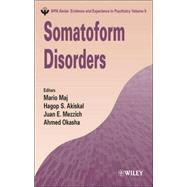
Note: Supplemental materials are not guaranteed with Rental or Used book purchases.
Purchase Benefits
What is included with this book?
Hagop S. Akiskal, University of California at San Diego, La Jolla, CA, USA, professor of Psychiatry and Director of International Mood Center.
Juan E. Mezzich, International Center for Mental Health, Mount Sinai School of Medicine, NYU,New York NY
Ahmed Okasha, Institute of Psychiatry, Ain Shams University, Cairo, Egypt, Director of WHO Collaborating Center
All are previous editors of WPA Series
| List of Review Contributors | xiii | ||||
| Preface | xv | ||||
| CHAPTER 1 SOMATIZATION AND CONVERSION DISORDERS | 1 | (66) | |||
|
1 | (22) | |||
|
|||||
|
|||||
|
23 | (3) | |||
|
|||||
|
26 | (3) | |||
|
|||||
|
29 | (2) | |||
|
|||||
|
31 | (3) | |||
|
|||||
|
34 | (4) | |||
|
|||||
|
38 | (2) | |||
|
|||||
|
40 | (2) | |||
|
|||||
|
42 | (2) | |||
|
|||||
|
44 | (3) | |||
|
|||||
|
47 | (3) | |||
|
|||||
|
50 | (2) | |||
|
|||||
|
52 | (3) | |||
|
|||||
|
55 | (2) | |||
|
|||||
|
57 | (2) | |||
|
|||||
|
59 | (3) | |||
|
|||||
|
62 | (3) | |||
|
|||||
|
65 | (2) | |||
|
|||||
| CHAPTER 2 PAIN DISORDER | 67 | (62) | |||
|
67 | (26) | |||
|
|||||
|
|||||
|
93 | (3) | |||
|
|||||
|
96 | (2) | |||
|
|||||
|
98 | (3) | |||
|
|||||
|
101 | (1) | |||
|
|||||
|
102 | (3) | |||
|
|||||
|
105 | (2) | |||
|
|||||
|
107 | (3) | |||
|
|||||
|
110 | (2) | |||
|
|||||
|
112 | (2) | |||
|
|||||
|
114 | (3) | |||
|
|||||
|
117 | (2) | |||
|
|||||
|
119 | (2) | |||
|
|||||
|
121 | (2) | |||
|
|||||
|
123 | (2) | |||
|
|||||
|
125 | (2) | |||
|
|||||
|
127 | (2) | |||
|
|||||
| CHAPTER 3 HYPOCHONDRIASIS | 129 | (62) | |||
|
129 | (32) | |||
|
|||||
|
|||||
|
161 | (3) | |||
|
|||||
|
164 | (3) | |||
|
|||||
|
167 | (3) | |||
|
|||||
|
170 | (2) | |||
|
|||||
|
172 | (2) | |||
|
|||||
|
174 | (3) | |||
|
|||||
|
177 | (2) | |||
|
|||||
|
179 | (2) | |||
|
|||||
|
181 | (2) | |||
|
|||||
|
183 | (2) | |||
|
|||||
|
185 | (2) | |||
|
|||||
|
187 | (4) | |||
|
|||||
| CHAPTER 4 BODY DYSMORPHIC DISORDER | 191 | (62) | |||
|
191 | (31) | |||
|
|||||
|
|||||
|
222 | (2) | |||
|
|||||
|
224 | (2) | |||
|
|||||
|
226 | (2) | |||
|
|||||
|
228 | (3) | |||
|
|||||
|
231 | (2) | |||
|
|||||
|
233 | (2) | |||
|
|||||
|
235 | (2) | |||
|
|||||
|
237 | (3) | |||
|
|||||
|
240 | (1) | |||
|
|||||
|
241 | (3) | |||
|
|||||
|
244 | (3) | |||
|
|||||
|
247 | (2) | |||
|
|||||
|
249 | (4) | |||
|
|||||
| CHAPTER 5 CHRONIC FATIGUE AND NEURASTHENIA | 253 | (72) | |||
|
253 | (32) | |||
|
|||||
|
|||||
|
285 | (2) | |||
|
|||||
|
287 | (4) | |||
|
|||||
|
291 | (3) | |||
|
|||||
|
294 | (3) | |||
|
|||||
|
297 | (2) | |||
|
|||||
|
299 | (3) | |||
|
|||||
|
302 | (3) | |||
|
|||||
|
305 | (3) | |||
|
|||||
|
308 | (3) | |||
|
|||||
|
311 | (2) | |||
|
|||||
|
313 | (3) | |||
|
|||||
|
316 | (3) | |||
|
|||||
|
319 | (2) | |||
|
|||||
|
321 | (2) | |||
|
|||||
|
323 | (2) | |||
|
|||||
| CHAPTER 6 FACTITIOUS PHYSICAL DISORDERS | 325 | (56) | |||
|
325 | (27) | |||
|
|||||
|
|||||
|
352 | (2) | |||
|
|||||
|
354 | (4) | |||
|
|||||
|
358 | (2) | |||
|
|||||
|
360 | (3) | |||
|
|||||
|
363 | (3) | |||
|
|||||
|
366 | (3) | |||
|
|||||
|
369 | (3) | |||
|
|||||
|
372 | (3) | |||
|
|||||
|
375 | (1) | |||
|
|||||
|
376 | (2) | |||
|
|||||
|
378 | (3) | |||
|
|||||
| Index | 381 |
The New copy of this book will include any supplemental materials advertised. Please check the title of the book to determine if it should include any access cards, study guides, lab manuals, CDs, etc.
The Used, Rental and eBook copies of this book are not guaranteed to include any supplemental materials. Typically, only the book itself is included. This is true even if the title states it includes any access cards, study guides, lab manuals, CDs, etc.